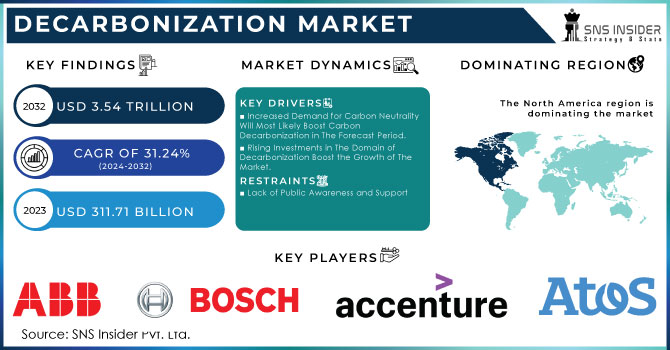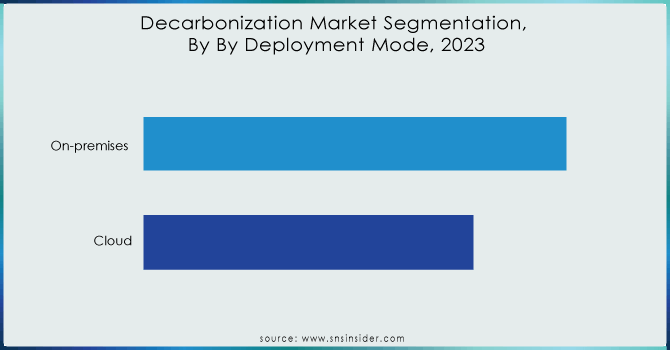Decarbonization Market Report Scope & Overview:
The Decarbonization Market was valued at USD 1906.1 Billion in 2023 and is expected to reach USD 5644.2 Billion by 2032, growing at a CAGR of 12.84% from 2024-2032. The adoption of decarbonization technologies like carbon capture, green hydrogen, and sustainable fuels is rising, driven by regulations and corporate sustainability goals. Renewable energy infrastructure is expanding globally, with investments in solar, wind, and grid modernization, while emission reductions vary by region based on carbon policies. Green energy consumption is increasing, supported by government incentives, with emerging trends in AI-driven energy optimization and blockchain for carbon credit trading.

Get More Information on Decarbonization Market - Request Sample Report
Market Dynamics
Drivers
- Governments and corporations are enforcing strict carbon policies and sustainability goals, driving investments in decarbonization technologies.
Decarbonizing is being driven rapidly by governments everywhere, using a mix of stringent carbon emission regulations, carbon pricing, and emission trading systems. Investment in renewables and sustainable technologies continue to gain momentum as a result of policies such as the EU Green Deal, the U.S. Inflation Reduction Act, and China's carbon neutrality targets. Moreover, net-zero pledges by corporations will drive an uptake of carbon capture, green hydrogen, and electrification solutions across industries. Furthermore, the rising need for sustainability reporting and ESG compliance drives businesses to embed decarbonization strategies which indirectly impacts the market growth.
Restraints
- The high upfront costs of carbon capture, green hydrogen, and renewable storage, along with inadequate infrastructure, hinder large-scale adoption.
Although interest in decarbonization technologies is expanding, their adoption is impeded by significant capital costs, with the high upfront price tags of carbon capture systems, green hydrogen production, and renewable energy storage discouraging many industries. Moreover, slow scaling is due to insufficient infrastructure for energy transmission, hydrogen transport, and carbon sequestration. Most developing economies face challenges in financing and a lack of institutional frameworks to support decarbonization efforts, thus limiting their transition to low-carbon solutions. The cost-effectiveness of utilizing decarbonization technologies is a critical challenge in the absence of significant government support and private-sector financing.
Opportunities
- Innovations in AI-driven energy optimization, green hydrogen, and blockchain-based carbon credit trading are unlocking new growth avenues.
New clean energy technology, including next-gen batteries, AI-optimized energy efficiency, and blockchain-based carbon credit trading, has been progressing swiftly enough to create major new opportunities in the decarbonization market. Green hydrogen, biofuels, and direct air capture technologies are maturing into globally commercializable solutions, generating both public and private investments. Moreover, the growing inter-industry collaborations and partnerships between research institutes and governments are accelerating progress in low-carbon technologies. With digital tools facilitating emissions monitoring in real-time and smart grid management, new markets are materializing as companies emerge with innovative solutions that will help them decarbonize faster and at reduced costs.
Challenges
- Transitioning from fossil fuels to renewables faces challenges like energy intermittency, policy uncertainties, and geopolitical risks.
Decarbonizing across different industries and geographies is still a major challenge because scaling the energy transition from fossil fuels to renewables is a complex process. The discontinuous character of solar and wind power and the heightened demand for effective storage are available through both technical and economic messages. Geopolitical considerations, policy uncertainties, and volatility in carbon credit pricing only make long-term investments in decarbonization more uncertain. This stakeholder-level market coordination is arguably one of the largest hurdles to overcome for a just energy transition in the context of balancing economic growth and environmental impact.

Need any customization research on Decarbonization Market - Enquiry Now
Segment Analysis
By Technology
In 2023, the renewable energy technologies segment dominated the market and accounted for a significant revenue share 2023, Due to the stringent government regulations concerning emissions, renewable energy plants in the region have increased. The country is experiencing a transition in the energy sectors — a shift from coal-based power generation to gas-based and renewable power.
The electric vehicle segment is projected to maintain a considerable CAGR throughout the forecast period. Tight regulations on vehicle emissions have fueled the demand for electric vehicles. On-road emissions are lower for electric vehicles than for other conventional vehicles.
By Service
The sustainable transportation services segment dominated the market in 2023 and accounted for a significant revenue share. Sustainable transportation encompasses environmentally friendly solutions, reducing carbon emissions, lowering resource consumption, and promoting equity in society. By providing effective mobility for people and goods, they help tackle the environmental and social issues related to conventional transportation solutions.
The carbon accounting and reporting services segment is projected to record the fastest CAGR during the forecast period. Carbon accounting services track, analyze, calculate, and communicate emissions within a company across sectors that need to be audited for greenhouse gases. It helps businesses to manage their carbon discharges.
By Deployment
In 2023, the on-premise segment dominated the market and accounted for 73% of revenue share. On-premises deployment in decarbonization signifies cutting back on carbon emissions, whether they arise from industrial processes, energy production, transportation, or buildings, to mitigate climate change. On-site renewable generation—including solar panels, wind turbines, and even small-scale hydroelectric facilities—can help facilities reduce their reliance on fossil fuels and the associated emissions from power consumption.
The cloud segment is projected to have the fastest growth rate. Cloud-based decarburization is an economical, highly scalable, and easy-to-execute, maintain, and upgrade solution for this purpose. Alongside it offers benefits such as security, data control, speed, and availability which is a 24/7 presence and truly helps to make it the best choice for clients.
By End-Use
The oil & gas segment dominated the market in 2023 and accounted for a significant revenue share in 2023. Decarbonization is the process of reducing or eliminating carbon dioxide (CO2) and other greenhouse gas emissions from the energy and utility sector that result from the supply and demand of energy. This is key to combating climate change and moving toward a greener, cleaner energy system in the future. The main approach to decarbonizing is to replace fossil fuels with renewable energy sources including solar, wind, hydropower, and geothermal energy.
The oil & gas segment is anticipated to grow at the fastest CAGR during the forecast period. Oil and gas companies are responsible for a large portion of global greenhouse gas emissions from fossil fuels and their extraction and production. Decarbonization in oil and gas means efforts to reduce the carbon footprint of the sector and eventual shift towards a low-carbon energy system.
Regional Analysis
North America dominated the market and accounted for a significant revenue share in 2023. Prominent players in the industry are increasingly indulging in the various initiatives that are contributing to the growth of the market. For example, in June 2023, the Biden-Harris Administration announced an investment of approximately USD 30 million in sustainable federal buildings and clean energy technologies via the U.S. Department of Energy. In a more recent example, the North American Climate, Energy, and Environment Partnership urged governments to set sustainable energy policies and buy renewable energy and electric vehicles, as they see fit.
The Asia Pacific region is projected to have the fastest CAGR during the forecast period. The growing installation of solar power projects in China, India, and other Asia Pacific countries is increasing the adoption of renewable energy in the region. Asia Pacific includes some of the largest solar panel markets across the globe, such as these three countries.

Key Players
The major key players along with their products are
- Siemens Energy – Silyzer (Electrolyzer for Green Hydrogen)
- General Electric (GE) – H-Class Gas Turbines (Hydrogen-Ready Power Generation)
- Schneider Electric – EcoStruxure (Energy Management & Optimization)
- ABB Ltd. – Terra HP (High-Power EV Charging Infrastructure)
- Honeywell – Carbon Capture Solutions (CCUS Technologies)
- Mitsubishi Heavy Industries (MHI) – Advanced Carbon Capture System (CO₂ Capture)
- Shell – Shell Blue Hydrogen (Low-Carbon Hydrogen Production)
- TotalEnergies – TotalEnergies Renewable Power (Solar & Wind Energy)
- Ørsted – Hornsea Wind Farms (Offshore Wind Power)
- ExxonMobil – ExxonMobil Low Carbon Solutions (CCUS and Biofuels)
- Air Liquide – Cryocap (CO₂ Capture Technology)
- Linde plc – Linde Hydrogen Fueling Stations (Hydrogen Infrastructure)
- BASF – OASE Blue (Carbon Capture for Industrial Use)
- Engie – Engie Green Hydrogen (Renewable Hydrogen Production)
- Climeworks – Direct Air Capture (DAC) Technology
RECENT DEVELOPMENTS
-
May 2024: The TEC under UNFCCC's Technology Mechanism noted global and regional efforts promoting decarbonization technologies in high-emission industrial sectors, accounting for 34% of global emissions.
-
February 2024: SECI launched India's largest solar-battery project in Chhattisgarh, combining solar panels and battery storage to store solar energy for peak demand, targeting significant annual CO2 emission reductions.
-
October 2023: Stargate Hydrogen and NextHeat formed a strategic partnership to develop innovative solutions for decarbonizing the industrial sector. They intend to replace natural gas with green hydrogen for applications such as industrial heating.
-
May 2023: Envision Digital and Dassault Systèmes have allied to pave the way toward industrial decarbonization by pairing the former's EnOS framework with the latter's 3DEXPERIENCE platform for energizing sustainable energy solutions and virtual twin experiences across industries.
| Report Attributes | Details |
|---|---|
| Market Size in 2023 | USD 1906.1 Billion |
| Market Size by 2032 | USD 5644.2 Billion |
| CAGR | CAGR of 12.84% From 2024 to 2032 |
| Base Year | 2023 |
| Forecast Period | 2024-2032 |
| Historical Data | 2020-2022 |
| Report Scope & Coverage | Market Size, Segments Analysis, Competitive Landscape, Regional Analysis, DROC & SWOT Analysis, Forecast Outlook |
| Key Segments | • By Technology (Renewable Energy Technologies, Energy Efficiency Solutions, Electric Vehicles (EVs), Carbon Removal Technologies, Carbon Capture and Storage (CCS)) • By Service (Carbon Accounting and Reporting Services, Sustainable Transportation Services, Waste Reduction and Circular Economy Services) • By Deployment (On-premises, Cloud) • By End-Use (Oil & Gas, Energy and Utility, Agriculture, Government, Automotive & Transportation, Aerospace & Defense, Manufacturing) |
| Regional Analysis/Coverage | North America (US, Canada, Mexico), Europe (Eastern Europe [Poland, Romania, Hungary, Turkey, Rest of Eastern Europe] Western Europe] Germany, France, UK, Italy, Spain, Netherlands, Switzerland, Austria, Rest of Western Europe]), Asia Pacific (China, India, Japan, South Korea, Vietnam, Singapore, Australia, Rest of Asia Pacific), Middle East & Africa (Middle East [UAE, Egypt, Saudi Arabia, Qatar, Rest of Middle East], Africa [Nigeria, South Africa, Rest of Africa], Latin America (Brazil, Argentina, Colombia, Rest of Latin America) |
| Company Profiles | Siemens Energy, General Electric (GE), Schneider Electric, ABB, Honeywell, Mitsubishi Heavy Industries (MHI), Shell, TotalEnergies, Ørsted, ExxonMobil, Air Liquide, Linde plc, BASF, Engie, Climeworks |

